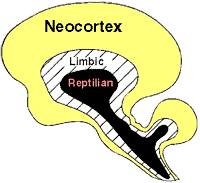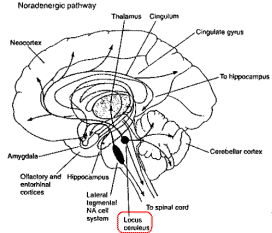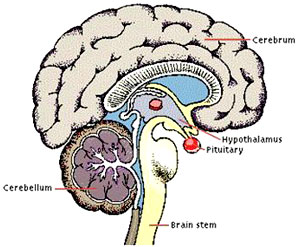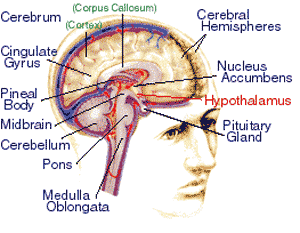|
6.- Russian ERV
To carry out ERV as practiced by Russian military remote viewers, it
is necessary to be in the
theta state. Both US and Russian extended
remote viewers use biofeedback and EEG monitoring to achieve this,
but I have developed a specialized technique to enable the remote
viewer to enter the theta state without electronic biofeedback.
THE BRAIN STRESS SYSTEM
Let us first look at the stress-related processes that make the
alpha and theta relaxed states so difficult to achieve. Within the
brain’s ancient neurological systems, the brain stem underpins our
higher brain structure. These ‘reptilian’ brain-stem structures have
evolved in such a way that they are now enclosed by the limbic
system and surrounding this, the cortex (Figure 12). These three
major brain structures are connected intimately to each other. Their
interaction controls our state of stress.
Ritualistic behaviour, adherence to the status quo, a rigid pecking
order, submission by inferiors and dominance over them, are some of
the chief factors that keep the reptilian brain from activating our
brain stress system; belief in leaders, the shared idea of the
material world being the only reality and its ineffaceable nature,
can also be included. The uncertain nature of our modern world,
however, puts us in a perpetual state of stress.

The locus ceruleus in the reptilian brain stem sends signals,
chemical and neuroelectric, to the hypothalamus which is part of the
limbic system. Emotional drives and urges are centered in the limbic
system which is the prime decision-making area of the brain. The
hippocampus, which controls memory and is intimately connected with
data retrieval and storage, is also centered in the limbic system, as
is the thalamus which is the organ of attention. Stress destroys our
ability to remember and concentrate on complex subjects - as all
exam-takers can testify. Anxiety and the level of activity of the
brain stress system therefore have an immense effect on the
mechanism of remote viewing. Anything which ameliorates the high
levels of chemical and electrical over-stimulation found in anxious
people will have profound effects on their remote viewing, mentation
and related data acquisition and retrieval.


Finally, there is a negative feedback process in the brain stress
system whereby high levels of blood cortisol act on the pituitary
gland and hypothalamus, which causes these areas to switch off or
lower the activity of the brain stress system. Unfortunately, the
locus ceruleus is not in this feedback loop. This has important
ramifications for remote-viewing operators.
-
The first is that any
disputes about dominance will constantly affect the brain stress
system
-
Secondly, any change from the status quo will constantly
stimulate the brain stress system
-
Thirdly, an environment in which
people don't know exactly what they are doing will have a similar
effect
This is because the reptilian brain likes
ordered
ritualistic behaviour where it knows what is going on.



Aiming to become master of your own mind and body and to develop
remote viewing, re-programmes the reptilian brain so that it becomes
fixated on the goal of remote viewing; in this state, you can ignore
stressors that would normally put you into a state of high anxiety.
A good example of this goal fixation of the reptilian brain is a
crocodile which will attack you if you throw sticks and stones at
it, or run away. If you tether a goat in front of a hungry
crocodile, it will ignore harassment and attack the goat.
STEPS FOR STRESS MANAGEMENT
1. Relax using the
relaxation techniques on pages before.
2. Visualize your attention focused on the thalamus part of the
brain (see Figure 14), which is in the limbic system, controlling
attention.
3. Concentrate your attention in the thalamus; visualize yourself in
this brain centre - the person that is you standing in your mind's
eye in your thalamus.
4. Visualize yourself in the thalamus picking up a laser-beam gun,
which is the mental representation of your will activating the
thalamus; visualize yourself unleashing this mental laser from your
thalamus.
5. Visualize the mental laser being so powerful it ignites your
thalamus, which bursts into a flashing ball of light and gives off a
mental laser that illuminates your entire brain in an explosion of
light. This mental laser light is called directed attention and is epicentred in this brain area.
6. Control your directed attention and focus this beam of mental
laser light on the locus ceruleus in your reptilian brain. Command
the locus ceruleus to shut down, preventing it from detonating the
brain stress system. So powerful is your mental laser that its light
can re-programme your brain centers.
7. Re-programme the
locus ceruleus to be totally fixated on remote
viewing and to ignore all stressors unless they are actually
life-threatening, by willing these thoughts down the mental laser
beam at your reptilian brain.
8. Next, focus the mental laser on your limbic system. Zoom in on
the hypothalamus, to lower the neurochemical and electrical
stimulation of your brain stress system, so that you reach the theta
state of consciousness.
9. Re-programme the hypothalamus to ignore all stressors unless they
are actually life-threatening. An example of how to programme these
non-language areas of the brain is to visualize your state of stress
as a big balloon of air which slowly deflates as you relax.
10. Next, let your mental laser beam travel to your pituitary gland
and command this gland to shut down the stress hormones that keep
your brain and body in a heightened state of anxiety all through the
day. Visualize yourself turning a tap to close the flow of
stress-inducing chemicals.
11. Return to the pituitary gland and
follow the hormonal pathways
to the adrenal glands on top of the kidneys. Fire your mental laser
at these glands and command your adrenal glands to shut down the
fight-or-flight hormonal response system and to boost the feedback
to shut down the brain stress system. Command the whole hormonal
system to shut down the brain stress system response, so your limbic
system is flooded with positive responses by use of remote viewing.
By this means, a very powerful feedback system is set up that lowers
your body’s stress levels every time you use remote viewing.
The above techniques are the most advanced form of
stress management
on the planet, used by the Russians.
Energy used by the brain and the biophysical fields is proportional
to frequency. In the beta state, the frequency can be around
28Hz
when anxious. In the theta state, the frequency can be around
7Hz.
This means that by operating in theta, you can think using one
quarter of the energy that is used in the beta state. By having such
an energy-efficient mode of thinking, the person in theta has enough
energy to think four times better, which can be four times faster,
or four times more in content. Using only one quarter of the energy
you would use in the beta state of consciousness enables you to
extend the time you can think and work by a factor of four.
This augmented intelligence and stamina can be put to use for remote
viewing. Psi activity requires energy for visualizing the
information coming from the biophysical fields. What is more, a lot
of energy is required to open a link to the biophysical fields.
Rather like lighting a match to ignite a fire, the biophysical field
needs energy to be released from the physical body, to resist the
PDF and to merge with the Earth's field for bilocation.
The last step in ERV after inculcating the theta state, is to
visualize the perceptual cues you get when you try to remotely view
a site of interest, for example:
-
Sense Perception
-
tactile hard
-
metallic
-
sounds rattle of cables
-
wind
-
visual iron tower
-
columns of iron
As before, remember to zoom in with your remote viewing on the
non-visual data first, as visual information dominates the attention
once you fix your awareness upon it. Build a mental image of the
attributes of your remotely perceived site, followed by a complete
picture of what it is. In the above case, the target was the Eiffel
Tower. Use the monitored remote-viewing method to build up your
perceptual cues if there is someone available to guide you through
advanced ERV.
Once you are in the theta state, repeat the simple ERV exercises
from this heightened state of consciousness. You will find that your
remote viewing dramatically improves. It will take at least a month
of practice before you can shorten the relaxation steps needed to
enter theta, but as the months go by, the theta state will become
more and more habitual with the concomitant increase in psi ability,
mental functioning and physical health.
Checklist for ERV
-
The theta state of mind is the first step in setting up extended
remote viewing.
-
Knowledge of the brain stress system mechanisms involved in lowering
the frequency of brain rhythms is the vital second step.
-
Next, develop focused thought processes, directed attention.
-
This directed attention is used to re-programme the brain stress
system to drop brain frequency from the beta state into the
theta
state. It can also be used to focus on the immune system to cure or
ameliorate disease.
-
Awareness can be projected out off the body, the basis of remote
viewing. The theta state is the doorway to the biophysical realm.
When in theta, the biophysical field resonates with the Earth's
natural frequency. In this state, the negative effect of the PDF is
suppressed by the Earth's larger biophysical field. This enables the
biophysical body to leave the physical body and begin extended
remote viewing. When your consciousness awakes in the biophysical
body, bilocation, the feeling of really being at the target, begins.
This is an analogous state to lucid dreaming.
-
Check-listing the sensory input you get from remote viewing map
co-ordinates can give useful information upon which to begin remote
viewing.
-
Directed attention fixated on the biophysical field, which is sent
to places you know, gives rise to remote-viewing awareness. Repeated
use of this awareness develops remote-viewing accuracy.
-
Sending your biophysical awareness to remotely view places of
interest is the next step. The more this technique is practiced, the
stronger your remote-viewing attention becomes.
-
A useful next step is to remotely view people you know or find of
interest. This leads to remote sensing.
-
In advanced remote viewing as
practiced by the Russians, directed
attention can grow to the point where you can remotely view
documents of interest and even access computer data by remote
viewing.
Back to
Contents
|





